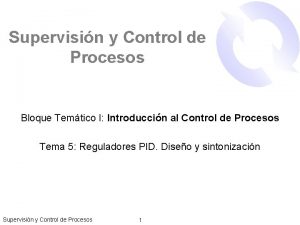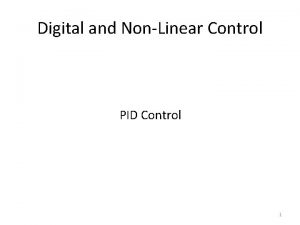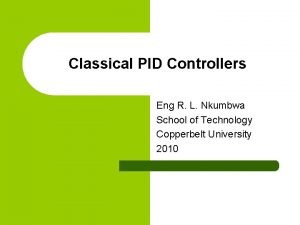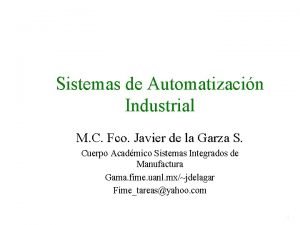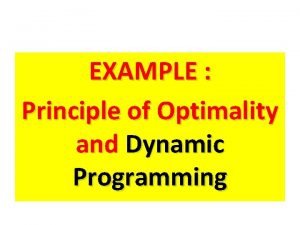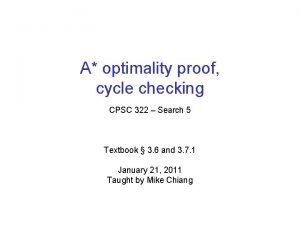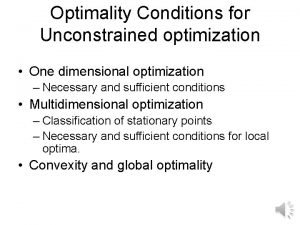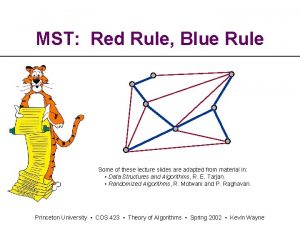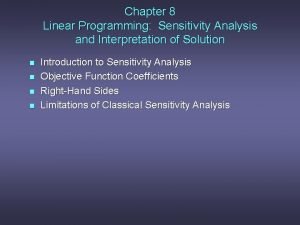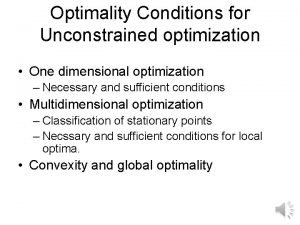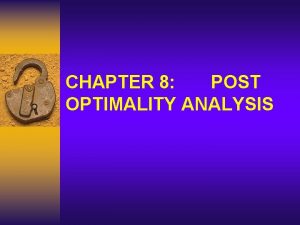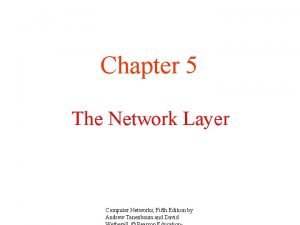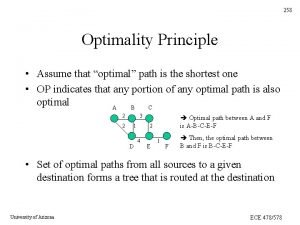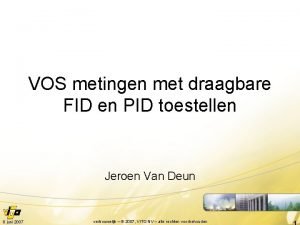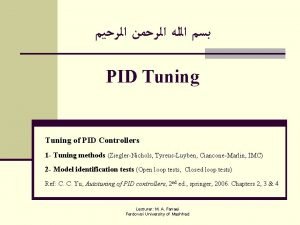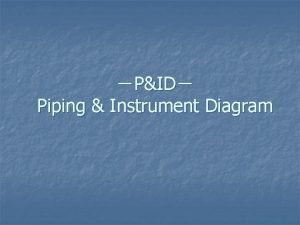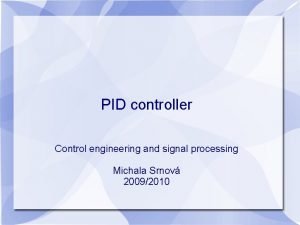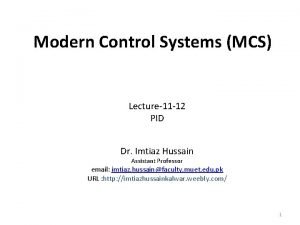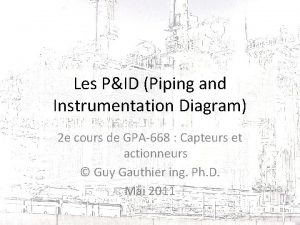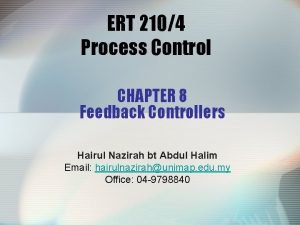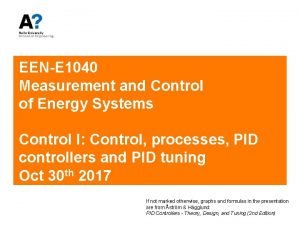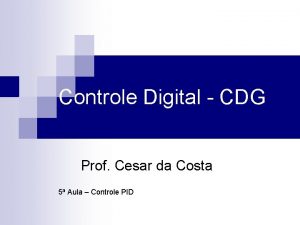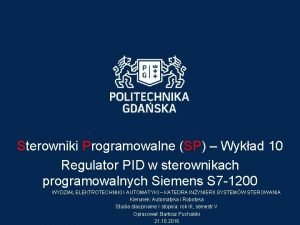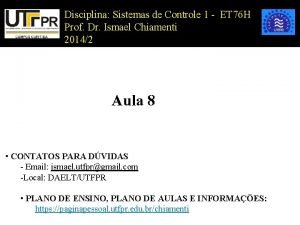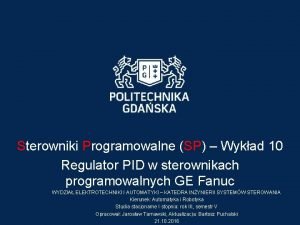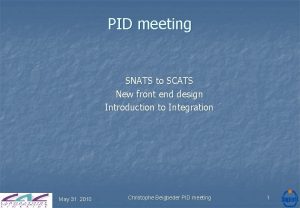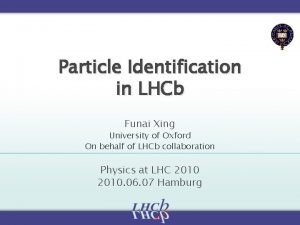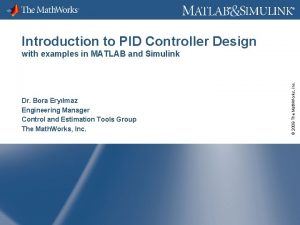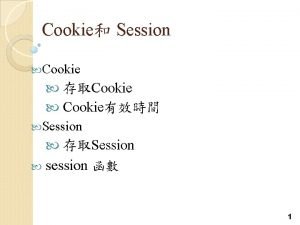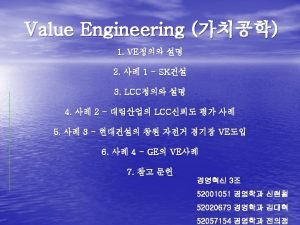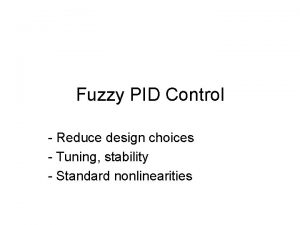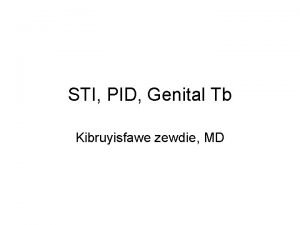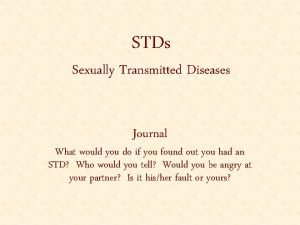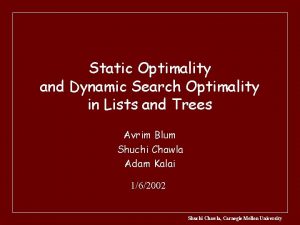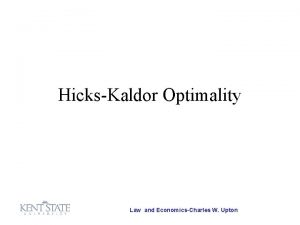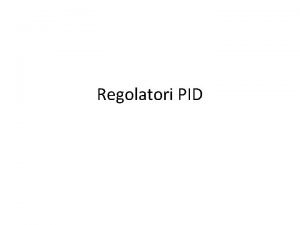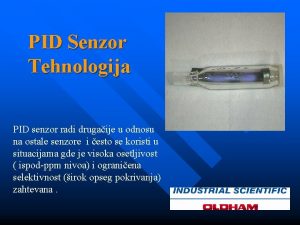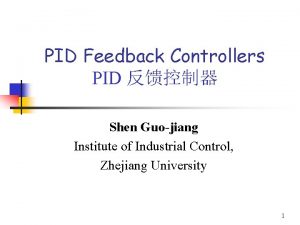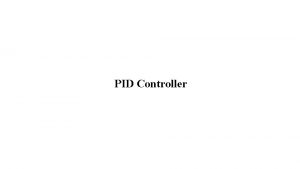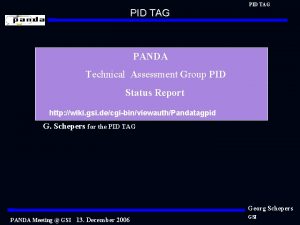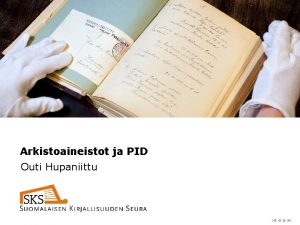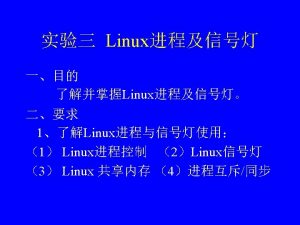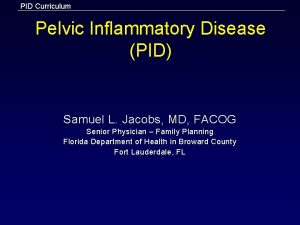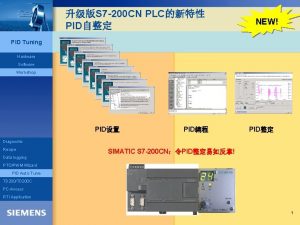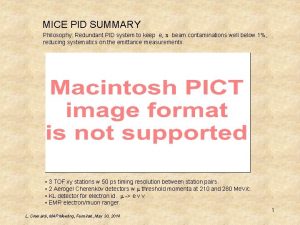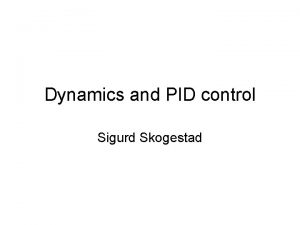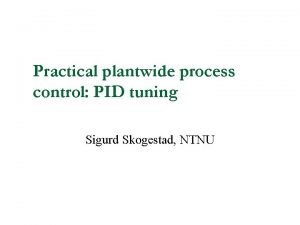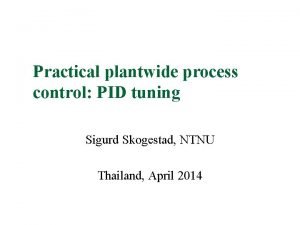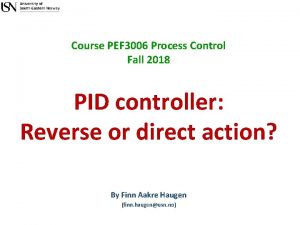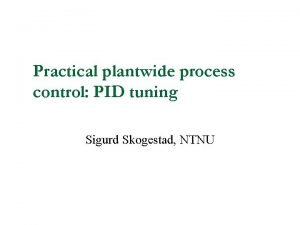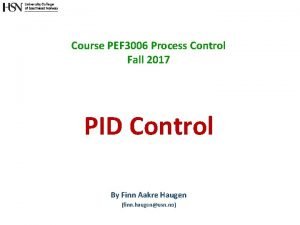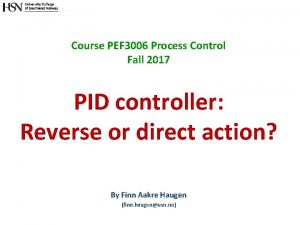1 Optimality of PID control for process control














































- Slides: 46

1 Optimality of PID control for process control applications Sigurd Skogestad Chriss Grimholt NTNU, Trondheim, Norway Ad. CONIP, Japan, May 2014

3 Trondheim, Norway

4

5 Operation hierarchy RTO CV 1 MPC CV 2 PID u (valves)

6 Outline 1. 2. 3. 4. 5. 6. 7. 8. Motivation: Ziegler-Nichols open-loop tuning + IMC SIMC PI(D)-rule Definition of optimality (performance & robustness) Optimal PI control of first-order plus delay process Comparison of SIMC with optimal PI Improved SIMC-PI for time-delay process Non-PID control: Better with IMC / Smith Predictor? (no) Conclusion

7 PID controller e • Time domain (“ideal” PID) • Laplace domain (“ideal”/”parallel” form) • For our purposes. Simpler with cascade form • Usually τD=0. Then the two forms are identical. • Only two parameters left (Kc and τI) • How difficult can it be to tune? ? ? – Surprisingly difficult without systematic approach!

8 Trans. ASME, 64, 759 -768 (Nov. 1942). Disadvantages Ziegler-Nichols: 1. Aggressive settings 2. No tuning parameter 3. Poor for processes with large time delay (µ) Comment: Similar to SIMC for integrating process with ¿c=0: Kc = 1/k’ 1/µ ¿I = 4 µ

9 Disadvantage IMC-PID: 1. Many rules 2. Poor disturbance response for «slow» processes (with large ¿ 1/µ)

10 Motivation for developing SIMC PID tuning rules 1. The tuning rules should be well motivated, and preferably be model-based analytically derived. 2. They should be simple and easy to memorize. 3. They should work well on a wide range of processes.

11 2. SIMC PI tuning rule 1. Approximate process as first-order with delay • • • k = process gain ¿ 1 = process time constant µ = process delay 2. Derive SIMC tuning rule: Open-loop step response c ¸ - : Desired closed-loop response time (tuning parameter) Integral time rule combines well-known rules: IMC (Lamda-tuning): Same as SIMC for small ¿ 1 (¿I = ¿ 1) Ziegler-Nichols: Similar to SIMC for large ¿ 1 (if we choose ¿c= 0) Reference: S. Skogestad, “Simple analytic rules for model reduction and PID controller design”, J. Proc. Control, Vol. 13, 291 -309, 2003

12 Derivation SIMC tuning rule (setpoints)

13 Effect of integral time on closed-loop response I = 1=30 Setpoint change (ys=1) at t=0 Input disturbance (d=1) at t=20

14 SIMC: Integral time correction • Setpoints: ¿I=¿ 1(“IMC-rule”). Want smaller integral time for disturbance rejection for “slow” processes (with large ¿ 1), but to avoid “slow oscillations” must require: • Derivation: • Conclusion SIMC:

15 Typical closed-loop SIMC responses with the choice c=

16 SIMC PI tuning rule c ¸ - : Desired closed-loop response time (tuning parameter) • For robustness select: c ¸ Two questions: • How good is really the SIMC rule? • Can it be improved? Reference: S. Skogestad, “Simple analytic rules for model reduction and PID controller design”, J. Proc. Control, Vol. 13, 291 -309, 2003 “Probably the best simple PID tuning rule in the world”

17 How good is really the SIMC rule? Want to compare with: • Optimal PI-controller for class of first-order with delay processes

18 3. Optimal controller • Multiobjective. Tradeoff between – – Output performance Robustness Input usage Noise sensitivity High controller gain (“tight control”) Low controller gain (“smooth control”) • Quantification – Output performance: • Rise time, overshoot, settling time • IAE or ISE for setpoint/disturbance – Robustness: Ms, Mt, GM, PM, Delay margin, … – Input usage: ||KSGd||, TV(u) for step response – Noise sensitivity: ||KS||, etc. Our choice: J = avg. IAE for setpoint/disturbance Ms = peak sensitivity

19 Output performance (J) IAE = Integrated absolute error = ∫|y-ys|dt, for step change in ys or d Cost J(c) is independent of: 1. process gain (k) 2. setpoint (ys or dys) and disturbance (d) magnitude 3. unit for time

Optimal PI-controller 20 4. Optimal PI-controller: Minimize J for given Ms Chriss Grimholt and Sigurd Skogestad. "Optimal PI-Control and Verification of the SIMC Tuning Rule". Proceedings IFAc conference on Advances in PID control (PID'12), Brescia, Italy, 28 -30 March 2012.

21 Optimal PI-controller Optimal PI-settings vs. process time constant ( 1 /θ) Ziegler-Nichols

22 Optimal PI-controller Optimal sensitivity function, S = 1/(gc+1) Ms=2 |S| Ms=1. 59 Ms=1. 2 frequency

23 Optimal closed-loop response Optimal PI-controller Ms=2 4 processes, g(s)=k e-θs/( 1 s+1), Time delay θ=1. Setpoint change at t=0, Input disturbance at t=20,

24 Optimal closed-loop response Ms=1. 59 Setpoint change at t=0, Input disturbance at t=20, g(s)=k e-θs/( 1 s+1), Time delay θ=1 Optimal PI-controller

25 Optimal closed-loop response Ms=1. 2 Setpoint change at t=0, Input disturbance at t=20, g(s)=k e-θs/( 1 s+1), Time delay θ=1 Optimal PI-controller

26 Par eto -o ptim Uninteresting al P I Infeasible

27 Optimal PI-controller Optimal performance (J) vs. Ms

31 5. What about SIMC-PI?

32 SIMC: Tuning parameter (¿c) correlates nicely with robustness measures Ms GM PM

33 What about SIMC-PI performance?

34 Comparison of J vs. Ms for optimal and SIMC for 4 processes

35 Conclusion (so far): How good is really the SIMC rule? • Varying C gives (almost) Pareto-optimal tradeoff between performance (J) and robustness (Ms) • C = θ is a good ”default” choice • Not possible to do much better with any other PIcontroller! • Exception: Time delay process

36 6. Can the SIMC-rule be improved? Yes, for time delay process

37 Optimal PI-controller Optimal PI-settings vs. process time constant ( 1 /θ)

Optimal PI-controller 38 Optimal PI-settings (small 1) 0. 33 Time-delay process SIMC: I= 1=0

39 Step response for time delay process Optimal PI θ=1 NOTE for time delay process: Setpoint response = disturbance responses = input response

40 Pure time delay process

41 Two “Improved SIMC”-rules that give optimal for pure time delay process 1. Improved PI-rule: Add θ/3 to 1 1. Improved PID-rule: Add θ/3 to 2

42 Comparison of J vs. Ms for optimal-PI and SIMC for 4 processes CONCLUSION PI: SIMC-improved almost «Pareto-optimal»

7. Better with IMC or Smith Predictor? n Surprisingly, the answer is: n NO, worse

Smith Predictor c K: Typically a PI controller Internal model control (IMC): Special case with ¿I=¿ 1 Fundamental problem Smith Predictor: No integral action in c for integrating process

45 Optimal SP compared with optimal PI ¿ 1=0 ¿ 1=1 ¿ 1=8 ¿ 1=20 since J=1 for SP for integrating process Small performance gain with Smith Predictor SP = Smith Predictor with PI (K)

46 Additional drawbacks with Smith Predictor • No integral action for integrating process • Sensitive to both positive and negative delay error • With tight tuning (Ms approaching 2): Multiple gain and delay margins

47 Step response, SP and PI y time Smith Predictor: Sensitive to both positive and negative delay error SP = Smith Predictor

48 Delay margin, SP and PI SP = Smith Predictor

50 8. Conclusion Questions for 1 st and 2 nd order processes with delay: 1. How good is really PI/PID-control? – Answer: Very good, but it must be tuned properly 2. How good is the SIMC PI/PID-rule? – Answer: Pretty close to the optimal PI/PID, – To improve PI for time delay process: Replace 1 by 1+µ/3 3. Can we do better with Smith Predictor or IMC? – No. Slightly better performance in some cases, but much worse delay margin 4. Can we do better with other non-PI/PID controllers (MPC)? – Not much (further work needed) • SIMC: “Probably the best simple PID tuning rule in the world”

51 Welcome to: 11 th International IFAC Symposium on Dynamics and Control of Process and Bioprocess Systems (DYCOPS+CAB). 06 -08 June 2016 Location: Trondheim (NTNU) Organizer: NFA (Norwegian NMO) + NTNU (Sigurd Skogestad, Bjarne Foss, Morten Hovd, Lars Imsland, Heinz Preisig, Magne Hillestad, Nadi
 Multi loop pid controller regolatore pid multi loop
Multi loop pid controller regolatore pid multi loop Perturbaciones
Perturbaciones Control pid
Control pid Classical pid control
Classical pid control “control de grua” and pid
“control de grua” and pid What is optimality principle in computer networks
What is optimality principle in computer networks What is optimality principle in computer networks
What is optimality principle in computer networks Principle of optimality
Principle of optimality Subnet
Subnet A* optimality proof
A* optimality proof Optimality conditions for unconstrained optimization
Optimality conditions for unconstrained optimization Blue rule
Blue rule 100 rule linear programming
100 rule linear programming Optimality conditions for unconstrained optimization
Optimality conditions for unconstrained optimization Post optimality analysis
Post optimality analysis Optimality principle in computer networks
Optimality principle in computer networks Optimality principle of routing
Optimality principle of routing Pid meting
Pid meting First lego league spike prime
First lego league spike prime Open office
Open office Piping and instrumentation diagram symbols
Piping and instrumentation diagram symbols Pid n
Pid n Pid rise time
Pid rise time Pid persistent identifier
Pid persistent identifier Modern control
Modern control Diagramme pid
Diagramme pid Pid lisom
Pid lisom Ert controller
Ert controller Pid rise time
Pid rise time Calculo pid
Calculo pid Pid 3 step
Pid 3 step Pid discharge pictures
Pid discharge pictures Pid discharge pictures
Pid discharge pictures Rtd symbol in p&id
Rtd symbol in p&id Controle pid
Controle pid Pid controller animation
Pid controller animation Pid isa
Pid isa Pid meeting
Pid meeting Pid xing
Pid xing Pid controller introduction
Pid controller introduction Addcart.php?pid=
Addcart.php?pid= Pid et pfd
Pid et pfd Pid panda
Pid panda Peach pid
Peach pid Pid
Pid Pid grading
Pid grading Std symptoms
Std symptoms

